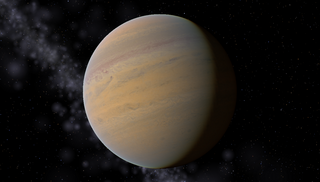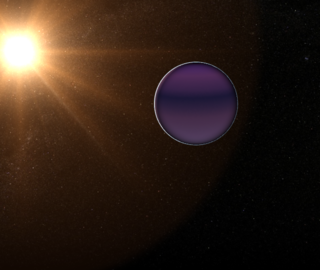Related Research Articles
HD 82943 is a yellow dwarf star approximately 89 light-years away in the constellation of Hydra. Two extrasolar planets have been confirmed to be orbiting it, and it is thought that the system had more giant planets that were "swallowed" by the parent star. HD 82943 is estimated at 1.15 times the mass of the Sun.
HD 169830 is a star in the southern constellation of Sagittarius. It has a yellow-white hue and is dimly visible to the naked eye with an apparent visual magnitude of +5.90. The star is located at a distance of 120 light years from the Sun based on parallax. It is drifting closer with a radial velocity of −17.3 km/s, and is predicted to come as close as 20.7 ly (6.4 pc) in 2.08 million years. HD 169830 is known to be orbited by two large Jupiter-like exoplanets.
HD 114729 is a Sun-like star with an orbiting exoplanet in the southern constellation of Centaurus. Based on parallax measurements, it is located at a distance of 124 light years from the Sun. It is near the lower limit of visibility to the naked eye, having an apparent visual magnitude of 6.68 The system is drifting further away with a heliocentric radial velocity of 26.3 km/s. The system has a relatively high proper motion, traversing the celestial sphere at an angular rate of 0.373″·yr−1.
HD 28185 is a yellow dwarf star similar to the Sun located 128 light-years away from Earth in the constellation Eridanus. The designation HD 28185 refers to its entry in the Henry Draper catalogue. The star is known to possess one long-period extrasolar planet.

HD 28185 b is an extrasolar planet 128 light-years away from Earth in the constellation of Eridanus. The planet was discovered orbiting the Sun-like star HD 28185 in April 2001 as a part of the CORALIE survey for southern extrasolar planets, and its existence was independently confirmed by the Magellan Planet Search Survey in 2008. HD 28185 b orbits its sun in a circular orbit that is at the inner edge of its star's habitable zone.
HD 73526 is a star in the southern constellation of Vela. With an apparent visual magnitude of +8.99, it is much too faint to be viewed with the naked eye. The star is located at a distance of approximately 316 light-years from the Sun based on parallax, and is drifting further away with a radial velocity of +26 km/s. It is a member of the thin disk population.

23 Librae b, also known as HD 134987 b, is an extrasolar Jovian planet discovered in November 1999 orbiting the star 23 Librae. It orbits in its star's habitable zone.
HD 11964 c is an extrasolar planet approximately 110 light-years away in the constellation of Cetus. The planet was discovered in a close-orbit around the yellow subgiant star HD 11964. The planet has a minimum mass 35 times the mass of Earth and is located in a mildly eccentric orbit which takes almost 38 days to complete. HD 11964 c was a possible planet discovered on the same day as HD 11964 b in 2005. HD 11964 c was first proposed in a paper published in 2007, and finally confirmed with new data presented in a review of multi-planet systems which appeared on the arXiv preprint website in 2008.
HD 11964 b is an extrasolar planet, a gas giant like Jupiter approximately 110 light-years away in the constellation of Cetus. The planet orbits the yellow subgiant star HD 11964 in a nearly-circular orbit, taking over 5 years to complete a revolution around the star at a distance of 3.34 astronomical units.

79 Ceti b is an extrasolar planet orbiting 79 Ceti every 75 days. Discovered along with HD 46375 b on March 29, 2000, it was the joint first known extrasolar planet to have minimum mass less than the mass of Saturn.

HD 2039 is a yellow dwarf or yellow subgiant star in the constellation Phoenix. The star is not visible to the naked eye, and lies 280 light years away from the Sun. HD 2039 is a relatively stable star, and an exoplanet at least three times the mass of the planet Jupiter has been discovered in its orbit; this exoplanet, known as HD 2039 b, was the 100th exoplanet to be discovered.
HD 68988 is a star in the northern constellation of Ursa Major. It has been given the proper name Násti, which means star in the Northern Sami language. The name was selected in the NameExoWorlds campaign by Norway, during the 100th anniversary of the IAU. HD 68988 is too faint to be seen with the naked eye, having an apparent visual magnitude of 8.20. The star is located at a distance of 199 light years from the Sun based on parallax. It is drifting closer with a radial velocity of −69 km/s and is predicted to come as close as 78 light-years in 617,000 years.
HD 114762 b is a small red dwarf star, in the HD 114762 system, formerly thought to be a massive gaseous extrasolar planet, approximately 126 light-years (38.6 pc) away in the constellation of Coma Berenices. This optically undetected companion to the late F-type main-sequence star HD 114762 was discovered in 1989 by Latham, et al., and confirmed in an October 1991 paper by Cochran, et al. It was thought to be the first discovered exoplanet

HD 76700 b is an exoplanet orbiting the G-type main sequence star HD 76700 approximately 198 light years away in the southern constellation Volans. The planet was discovered in 2002, and was announced in 2003.
HD 188015 b is an extrasolar planet announced by the California and Carnegie Planet Search team in 2005. Like majority of known planets, it was discovered using the radial velocity method.
HD 210277 b is an extrasolar planet orbiting the star HD 210277. It was discovered in September 1998 by the California and Carnegie Planet Search team using the highly successful radial velocity method. The planet is at least 24% more massive than Jupiter. The mean distance of the planet from the star is slightly more than Earth's distance from the Sun. However, the orbit is very eccentric, so at periastron this distance is almost halved, and at apastron it is as distant as Mars is from the Sun.
HD 30177 b is an extrasolar planet located approximately 181.6 light-years away in the constellation of Dorado, orbiting the star HD 30177.
HD 40979 b is an extrasolar planet orbiting the star HD 40979, was detected from the Lick and Keck observatories and photometric observations at Fairborn Observatory reveal low-amplitude brightness variations in HD 40979. It is thought to be a large gas giant planet. It was discovered in 2002 by Debra Fischer.
HD 46375 b is an extrasolar planet located approximately 109 light-years away in the constellation of Monoceros, orbiting the star HD 46375. With 79 Ceti b on March 29, 2000, it was joint first known extrasolar planet less massive than Saturn orbiting a normal star. The planet is a "hot Jupiter", a type of planet that orbits very close to its parent star. In this case the orbital distance is only a tenth that of the planet Mercury. No transit of the planet has been detected, so its inclination must be less than 83°. Because the inclination is unknown, the true mass of the planet is not known.
HD 102117 b, formally named Leklsullun, is a planet that orbits the star HD 102117. The planet is a small gas giant a fifth the size of Jupiter. It orbits very close to its star, but not in a "torch orbit" like the famous 51 Pegasi b. It was one of the smallest extrasolar planets discovered as of 2006.
References
- ↑ Tinney, C. G.; et al. (2003). "Four New Planets Orbiting Metal-enriched Stars". The Astrophysical Journal. 587 (1): 423–428. arXiv: astro-ph/0207128 . Bibcode: 2003ApJ...587..423T . doi: 10.1086/368068 .
- ↑ Butler, R. P.; et al. (2006). "Catalog of Nearby Exoplanets". The Astrophysical Journal. 646 (1): 505–522. arXiv: astro-ph/0607493 . Bibcode: 2006ApJ...646..505B . doi: 10.1086/504701 .